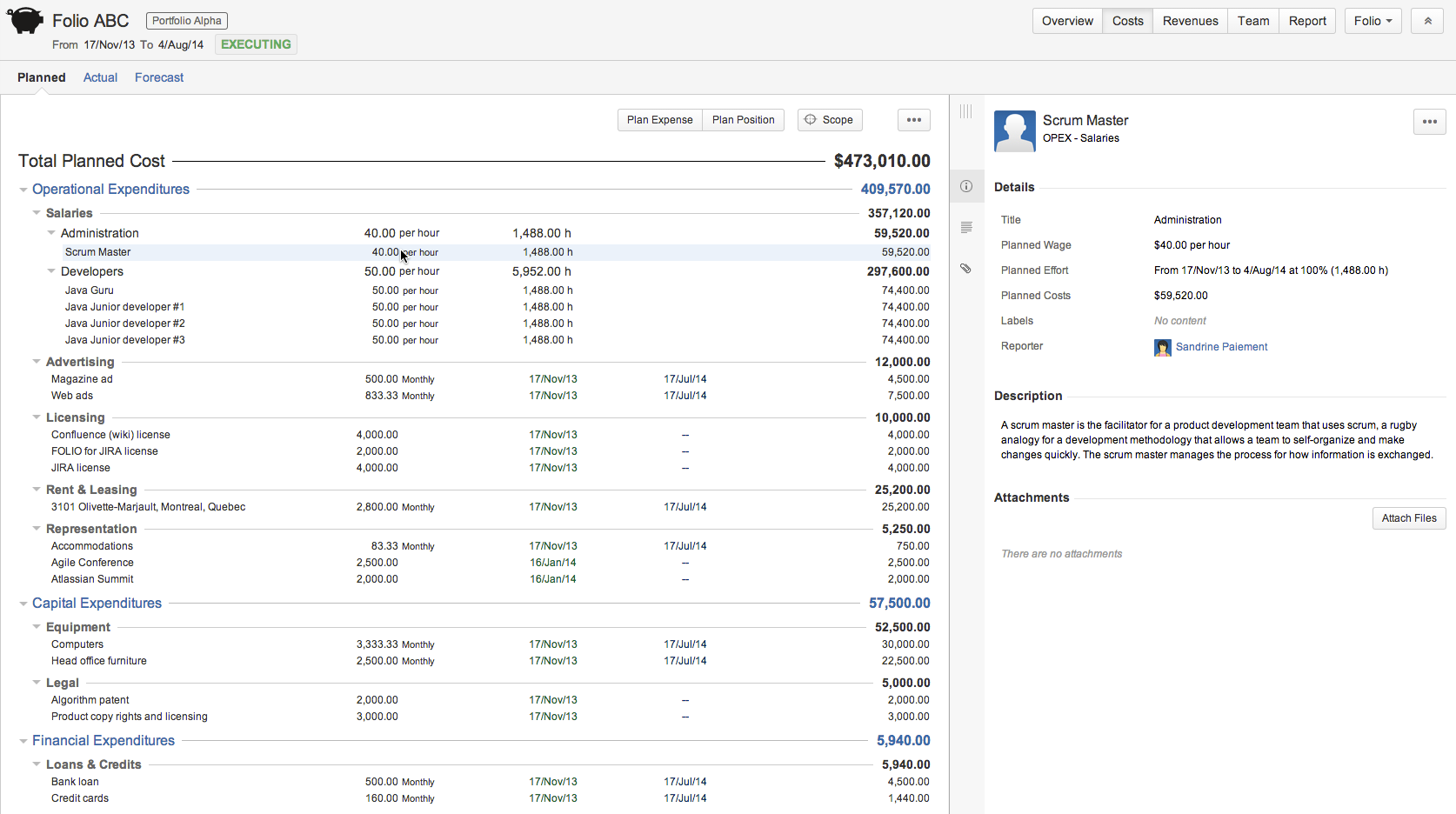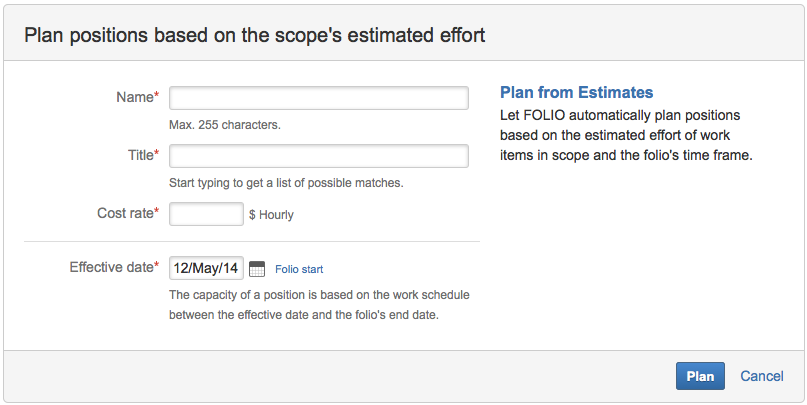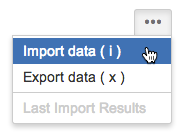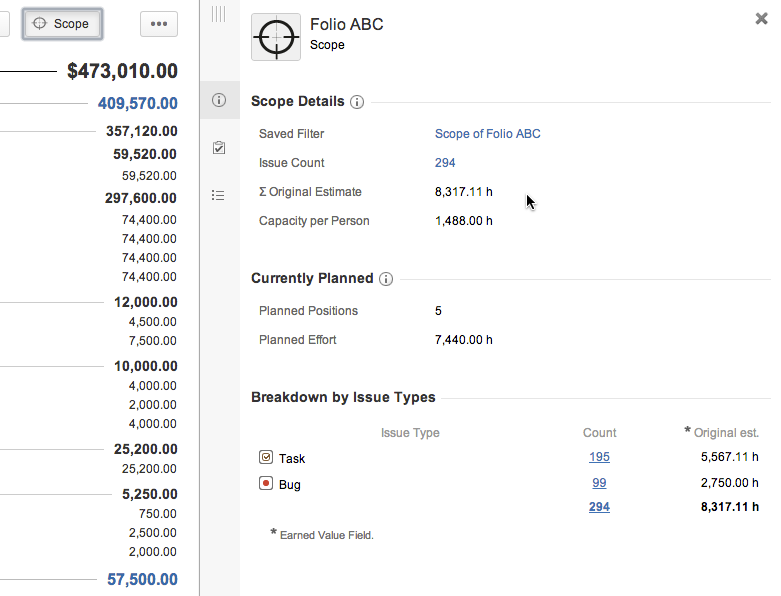The Planned Costs page allows you to enter all expenses and all team positions you expect the Folio will require during its lifespan. Expenses are added to one of three main categories: Operational expenditures (OPEX), Capital expenditures (CAPEX) or Financial expenditures (FINEX). Expenses can be single occurrence or recurrent ones. Positions are the team members you will need to accomplish the work, such as developers, testers, team leads, etc. and are added to the operational expenditures. Information entered here will be used to provide project health metrics on the Overview page and shown as a reference on the Costs Forecast chart. 
ExpensesExpenses are the all the expenses you plan the Folio will incur at one point or another. The Planned Costs page shows the calculated cost for each expense and expense groups (by type). You can collapse (or expand) a group of expenses by clicking the triangle icon (  ) next to an expense type. ) next to an expense type. See the Expenses page for more information on expenses and how their cost is calculated. Planning an expenseTo add an expense, either click the Plan Expense button or hit the "a" (for add) shortcut key. This brings the expense edition dialog. Refer to the Editing an Expense section to learn how to fill the edition dialog. Check the Plan another box at the bottom of the dialog in order to create many expenses in sequence. | Include Page |
|---|
| Expense Operations |
|---|
| Expense Operations |
|---|
|
| Anchor |
|---|
| CopyExpenseToActual |
|---|
| CopyExpenseToActual |
|---|
|
Copying an expense to actualSelect an existing expense to copy to actual by clicking on it and then either click on the drop-down menu on the top-right part of the expense details view (on righthand side of the screen) and select the Copy to actual option or hit the "t" (for to Actual) shortcut key. This will copy the selected expense to actual, including its attached files. You can copy multiple expenses to actual at once by selecting them in the budget (by pressing and holding the Control key while clicking the expenses to copy). You can then copy the selected expenses the same way you copy a single expense. The confirmation message will inform you of how many expenses have been copied. PositionsPositions are the salary expenses you plan the Folio will incur at one point or another. The planned costs page shows the calculated cost for each position and position groups (by title). The cost displayed on group title rows is simply the sum of the costs of the positions in that group. You can collapse (or expand) a group of positions by clicking the triangle icon (  ) next to a position title. ) next to a position title. See the Positions page for more information on positions and how their cost is calculated. Planning a positionTo plan a position, either click the Add Position button or hit the "o" (for position) shortcut key. This brings up a position edition dialog. Check the Plan another box at the bottom of the dialog in order to create many positions in sequence. 
 |  | Show the available time remaining in the folio. This note is update while
you change the effort helping you to adjust the effort plan. | You can enter number of hours allocated for a specified period
or an allocation percentage. |
| Anchor |
|---|
| BudgetAddingPosition |
|---|
| BudgetAddingPosition |
|---|
|
Name | Name of the position Examples: J2EE Developer 1, Database Administrator |
|---|
Title | Title that will be used to classify positions. While typing in this field, titles entered previously for other positions that match what you typed will be suggested to you for completion to help you avoid typos and duplications. Examples: Developer, Q&A, Management, etc. |
|---|
Cost rate
| Cost of an hour for this position (wage) |
|---|
| Repeat | Number of positions to create. Example: if repeat is 6 FOLIO will create six positions. All created positions will have the same exact values (title, wage, ...). |
|---|
Effort | Amount of time the position is planned to be active during the folio. The effort can be entered in one of two ways: - By specifying an amount of time starting at some date. Time will be dispatched based on normal working hours per day as specified in configured Working Schedule.
- By specifying a percentage of normal business hours or an amount of time between two dates. In the first case, the planned effort will be calculated based on the normal hours per day configured in the Working Schedule. In the second case, the specified time will be evenly dispatch between start date and end date. Select the way that best suits your available estimation data.
The effort will be displayed as a number of hours in the Planned costs screen, no matter how the value was entered. |
|---|
| Labels | JIRA Issue Label to associate the position with Refer to Labels for more details. |
|---|
Description | An optional, free form description of the position. |
|---|
| Anchor |
|---|
| FromEstimates |
|---|
| FromEstimates |
|---|
|
Planning positions from estimatesYou can ask FOLIO to automatically plan positions based on the estimated effort of issues in scope within the folio's time frame. - Derive planned positions to match the sum of original estimates of the Folio's scope.
- Completes budgeted positions if your currently planned positions are not sufficient to match the estimated effort.

Name | Name of the positions Examples: J2EE Developer 1, Database Administrator |
|---|
Title | Title that will be used to classify positions. While typing in this field, titles entered previously for other positions that match what you typed will be suggested to you for completion to help you avoid typos and duplications. Examples: Developer, Q&A, Management, etc. |
|---|
Cost rate
| Average cost of an hour for these positions (wage) |
|---|
Effective date
| The capacity of a position is based on the work schedule between the effective date and the folio's end date. |
|---|
Select an existing position to modify by clicking on it and then either click on the ... menu on the top-right part of the details panel (on righthand side of the screen) and select the Edit option or hit the e (for edit) shortcut key. This brings up the edition dialog. Refer to Adding a position section for a detailed description of the edition dialog. | Anchor |
|---|
| DeletePosition |
|---|
| DeletePosition |
|---|
|
Deleting a positionSelect an existing position to delete by clicking on it and then either click on the ... menu on the top-right part of the details panel (on righthand side of the screen) and select the Delete option or hit the d (for delete) shortcut key. This brings up a dialog to confirm the deletion. Click the Delete button to confirm the deletion, or Cancel link to abort. Deletion is permanent, thus make sure you really want to delete a position before proceeding. You can delete multiple positions (and even a mix of expenses and positions) at once. Refer to the Multiple Selection to learn how to perform a batch deletion. Import / ExportFOLIO Allows you to import or export your data in CSV (comma separated values) format. 
Importing Planned CostsTo import data from an existing CSV file, click on the ... button and select Import data. Alternatively, you can type the keyboard shortcut i to open the import dialog. See Importing Data from CSV and Planned Costs/Revenues Import to learn more about importing Planned Costs. Exporting Planned CostsTo export data to an external CSV file click on the ... button and select Export data. Alternatively, you can type the keyboard shortcut x to instantly export data. Exported CSV file includes both planned positions and expenses. See Planned Costs or Revenues CSV Export Detail to learn more about export data. Scope InspectorThe scope inspector allows you to view the breakdown of the Folio's scope by issue type (user stories, bugs, etc.) and see if the planned positions have a capacity that matches the effort required for that scope. It will help you answer questions such as: - Are the planned salaries sufficient to implement the planned features of our application?
- How much required effort has been estimated for the planned scope? How much to fix the known bugs?
- What's the maximum effort a person can possibly provide given the current Folio's time frame?
Clicking the Scope button brings up that information in the details panel on the right. 
| Details |
|---|
 Scope Inspector Scope Inspector | Shows or hides Scope Inspector. |
|---|
| X | Hides the Scope Inspector. |
|---|
 | Inline Help. Clicking on the icon opens up an inline dialog containing definitions of elements displayed in section. |
|---|
| Saved filter | Clicking on Saved Filter link displays all JIRA issues included in your Folio's scope |
|---|
| Capacity per Person | A single person's capacity in terms of regular working hours given the Folio's time frame and the Working Schedule configuration. |
|---|
| Planned positions | Total number of positions currently planned |
|---|
| Planned Effort | Total number of working hours currently planned |
|---|
| Breakdown By Issue Type |
|---|
| Issue Type | Type of issues (User Story, Task, Bug, etc.) |
|---|
| Count | Total number of issues by type |
|---|
| Earned Value Field | Sum of the Earned Value Field for all issues of given type. Will not be display if earned value field is Original Estimate. |
|---|
| Original Estimate | Sum of Original Estimate for all issues of given type. |
|---|
|